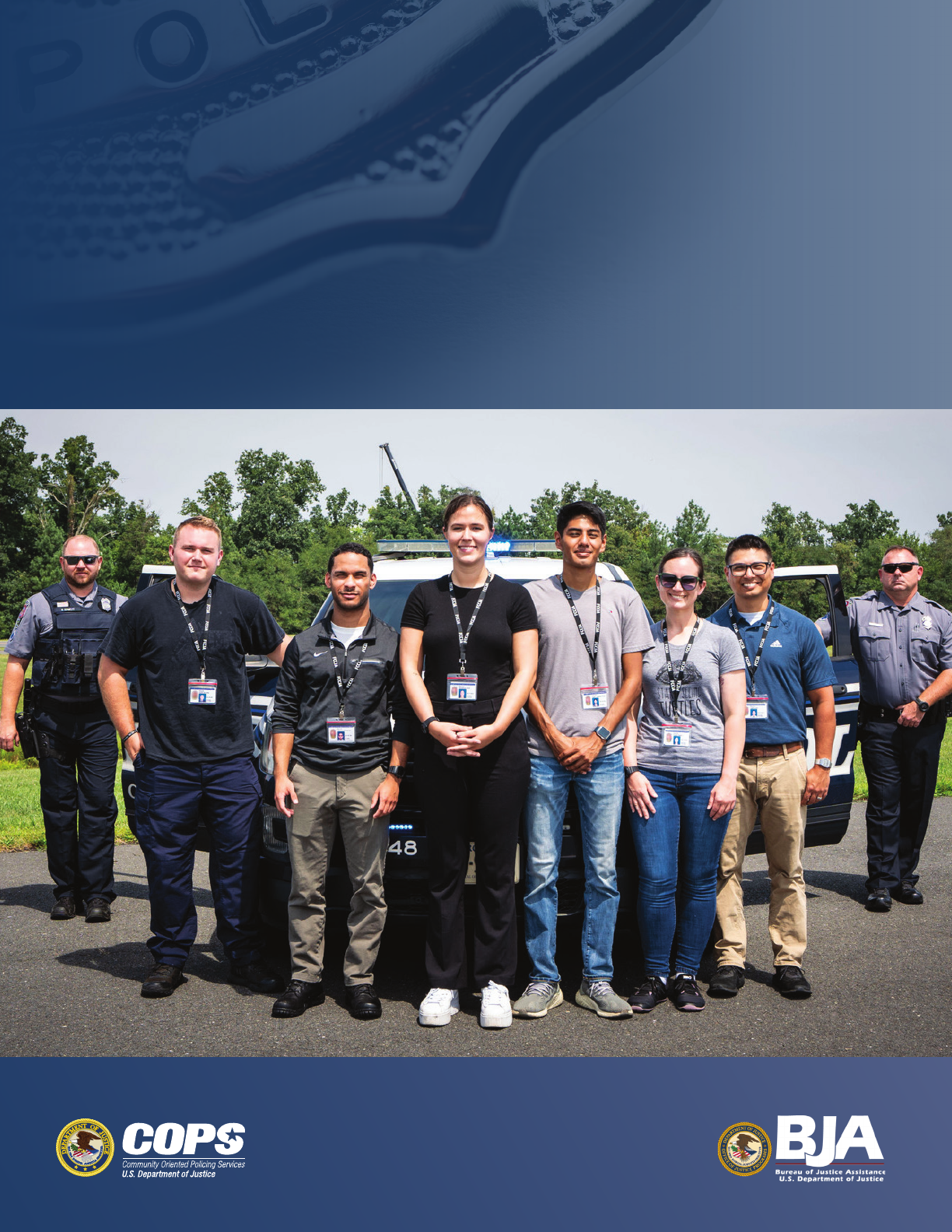
Recruitment and Retention
for the Modern
Law Enforcement Agency
Bureau of Justice Assistance and Office of Community Oriented Policing Services
The opinions contained herein are those of the forum participants and do not necessarily represent the official position or policies of the U.S. Department of Justice.
The internet references cited in this publication were valid as of the date of publication. Given that URLs and websites are in constant flux, neither the author(s), the contribu-
tor(s), the Bureau of Justice Assistance, nor the COPS Office can vouch for their current validity.
This resource may be subject to copyright. The U.S. Department of Justice reserves a royalty-free, nonexclusive, and irrevocable license to reproduce, publish, or otherwise
use and to authorize others to use this resource for Federal Government purposes. This resource may be freely distributed and used for noncommercial and educational
purposes only.
Recommended citation:
Bureau of Justice Assistance and Office of Community Oriented Policing Services. 2023. Recruitment and Retention for the Modern Law Enforcement Agency. Washington, DC:
Office of Community Oriented Policing Services.
Published 2023


Contents
Letter from the Directors of the Bureau of Justice Assistance and the Office of Community Oriented Policing Services ........
................................................................................................................
...............................................................................................
..........................................................................................................
.................................................................................................
v
Introduction 1
Eligibility and Hiring Practices 3
Solutions 3
Recommendations 8
Training.....................................................................................................................
..........................................................................................................
................................................................................................
.....................................................................................................
.........................................................................................................
................................................................................................
.....................................................................................
.........................................................................................................
................................................................................................
.............................................................................................
.........................................................................................................
................................................................................................
9
Solutions 9
Recommendations 12
Benefits and Incentives 13
Solutions 13
Recommendations 15
Work-Life Balance and Officer Wellness 17
Solutions 17
Recommendations 21
Diversity, Equity, and Inclusion 23
Solutions 23
Recommendations 27
Culture ....................................................................................................................
.........................................................................................................
................................................................................................
...................................................................................................
.........................................................................................................
................................................................................................
29
Solutions 29
Recommendations 30
Law Enforcement Image 31
Solutions 31
Recommendations 35
iii

Pipeline Programs..........................................................................................................
.........................................................................................................
................................................................................................
.................................................................................................................
................................................................................................................
..........................................................................................
...................................................................................
.................................................................................
.................................................................................................................
.....................................................................................................
37
Solutions 37
Recommendations 42
Conclusion 43
Appendices 45
Appendix A. Participants 45
Appendix B. Recommendations 48
Appendix C. Government Actions 51
About BJA 52
About the COPS Office 53
iv Recruitment and Retention for the Modern Law Enforcement Agency

Letter from the Directors of the
Bureau of Justice Assistance and the
Office of Community Oriented
Policing Services
Colleagues:
It is no secret that recruitment and retention are serious obstacles facing law enforcement today. The profession, by its very
nature, challenges law enforcement professionals both physically and mentally. Society’s ever-changing nature, needs, and
expectations add another complex layer to policing. In recent years, several significant events have led to rapid changes and shifts
in community expectations of what people want from their police and other public servants. These changes and accompanying
challenges have played a part in departments’ struggles to attract potential applicants to fill positions left vacant by retirement and
to reduce or prevent the increasing number of resignations.
The United States Attorney General, recognizing the need to have a national discussion on and identification of recommenda-
-
tions to address police recruitment and retention through the modernization of the police profession, requested a convening
of law enforcement and community leaders to examine strategies and promising practices around this issue. This document
represents the recommendations that resulted from the meeting, held on April 18, 2023. The Bureau of Justice Assistance (BJA)
and the Office of Community Oriented Policing Services (COPS Office) were honored to host this event.
Prior to the meeting, participants identified discussion topics to allow for robust conversations on how our nation might move
forward in addressing police workforce challenges and meeting the needs of our communities. The outlined recommenda
tions focus on potential strategies and solutions that might be implemented at the agency level as well as possible actions
that local and state governments and the Federal Government might take to support these changes. It is important to
acknowledge that there is no one-size-fits-all solution and that agencies and governments are best positioned to consider their
resources and limitations.
We wish to thank the convening participants for their expertise, time, and contributions. This publication reflects their work and
voices on how we may move forward, together, to support our law enforcement and communities. There is work to be done,
and we are committed and honored to partner with and support our law enforcement colleagues.
With gratitude,
Karh
lton F. Moore
Dire
ctor
Bureau of Justice Assistance
v
Hugh T. Clements, Jr.
Director
Office of Community Oriented Policing Services

Introduction
In the wake of the COVID-19 pandemic, a tightening labor market, heightened community frustration with the policing profession,
and concerns about officer safety and well-being, law enforcement agencies across the country face an historic crisis in
recruiting and retaining qualified candidates.
1
As agencies continue to seek innovative ways to attract qualified potential candidates
and retain current staff, the crisis demands an immediate and effective response to ensure that law enforcement agencies can
maintain staffing levels sufficient to support their communities’ public safety needs. Addressing these issues may necessitate the
reexamination of agencies’ foundational organizational structure and processes to more clearly and easily meet the needs and
expectations of both law enforcement and the community.
In response to this situation
and recognizing that the way law enforcement professionals are recruited and retained has a major
impact on violent crime reduction, overall public safety, and community trust—Attorney General Merrick Garland identified law
enforcement recruitment and retention as a U.S. Department of Justice priority and directed the Office of Justice Programs’
Bureau of Justice Assistance (BJA) and the Office of Community Oriented Policing Services (COPS Office) to hold a convening. On
April 18, 2023, a group of more than 30 law enforcement and community leaders
2
from across the country met in Washington,
D.C., to discuss existing best practices and emerging and transformative solutions designed to address current staffing challenges.
In addition to command staff and other law enforcement leaders from key stakeholder associations, other new vocal and innovative
leaders were in attendance to assist in designing a national solution. As Associate Attorney General Vanita Gupta noted in her
o
pening remarks, the issues of recruitment and retention are among the most important faced by federal, state, local, tribal, an
d
t
erritorial law enforcement agencies across the nation, regardless of size or location. The agenda was driven by informatio
n
obtained from the participants during brief interviews conducted prior to the event and designed to promote meaningful,
ac
tionable discussion.
This publication represents the outcomes of the convening, focusing on both short-term strategies and long-term solutions
identified by participants, who shared examples of streamlining and modernizing the hiring process, incorporating technology,
updating requirements, and increasing accessibility; discussed marketing strategies designed to attract service-oriented candi-
dates; examined existing and potentially new benefits and incentives, including a focus on employee wellness and mental
well-being, to entice current employees to stay; and addressed the need for transparency and accountability throughout the
hiring and employment process to promote public confidence. While there is no one-size-fits all solution for the law
enforcement recruitment and retention challenge, agencies are encouraged to consider adopting strategies contained herein
as they pertain to their individual situations.
1. PERF (Police Executive Research Forum), “New PERF Survey Shows Police Agencies Are Losing Officers Faster than They Can Hire New Ones,” last
modified April 1, 2023, https://www.policeforum.org/staffing2023.
2. See appendix A for a list of attendees.
1

The goal of this document is to provide practical guidance and specific recommendations for
consideration by all law enforcement agencies; however, each recommendation taken alone is
not enough to successfully address the problem. Instead, each should be viewed as part of a
comprehensive review and evaluation of agency strategies. Recommendations have been
identified at the end of each section as potentially being either short-term solutions (noted with
an S), taking less time to implement, or long-term strategies (noted with an L), taking a greater
amount of time to implement. Recommendations identified with an S/L are those that may
require a short-term action followed by a longer implementation strategy.
2 Recruitment and Retention for the Modern Law Enforcement Agency

Eligibility and Hiring Practices
Recruiting and retaining qualified law enforcement officers in the 21st century requires executives and hiring professionals to
modernize policing from the ground up. While funding to examine the effects of hiring on policing may provide additional
insight on how to best address the current crisis, leaders must take action immediately to begin addressing the problem. Spe-
-
-
cifically, agencies must reevaluate their eligibility requirements, hiring processes, academy structures, and training to accurately
reflect policing today.
Solutions
Analyze communities’ needs
Agencies should consider the changing nature of policing and work with the community to establish how law enforcement can best serve
their needs.
Prior to enacting any meaningful change regarding recruitment and retention within their agencies, police leaders should ana
lyze how and whether their current and future employees, as well as related policies and procedures, meet the needs of the
communities they serve. To better understand how best to recruit effective candidates, the agency must first directly and mean
ingfully engage a wide variety of community members to understand the community’s expectations, conduct an analysis of the
skill sets required to meet those expectations, and identify gaps that may exist. Instead of relying solely on available data and
statistics, the analysis should directly involve members from a variety of segments of the community, including individuals from
different age, socioeconomic, and ethnic groups. This community engagement can be achieved through individual interactions
and interviews, town halls, and the use of technology such as online forums and comment forms. Refining the job description
of the modern police officer allows the profession to move forward in an informed manner when reviewing its hiring practices.
Modernize eligibility requirements
Police officers in today’s society are often expected to perform a wider variety of tasks than they may have expected in the past,
as law enforcement may be called upon to handle tasks like rendering emergency aid or collaborating with other professionals
in responding to individuals experiencing behavioral health crises (but see “Crisis Assistance Helping Out On The Streets
(CAHOOTS) Program” on page 34 for discussion of alternative, nonpolice responses to many such behavioral health calls for
service).
3
Therefore, officers must possess a variety of skills, many of which are not currently included in the application, hiring,
and training processes.
Law enforcement agencies should examine their eligibility requirements and the skill sets they are seeking to ensure that they are aligned
with the work that police officers do every day.
There was a consensus among meeting participants that eligibility requirements for hiring need to be updated to reflect a more
modern culture. It is important to note that this change does not translate to lowering standards but instead allowing for evo-
lution of standards to align with the realities of policing in the 21st century. In addition to identifying candidates who meet the
3. Sue Rahr and Stephen K. Rice, From Warriors to Guardians: Recommitting American Police Culture to Democratic Ideals, New Perspectives in Policing
(Washington, DC: National Institute of Justice, 2015), https://www.ojp.gov/pdles1/nij/248654.pdf.
3

minimum standards, agencies should seek to attract those who possess character traits and values that align with their com-
-
-
munity. In addition, agencies may consider categorizing some requirements as immediate (e.g., lack of criminal history) while
allowing recruits additional time, such as during the academy, to meet other requirements (e.g., physical fitness).
Participants at the convening identified the usefulness and supported the development of a national standard for police hiring
developed by accrediting bodies. They also recommended that agencies consider their current eligibility requirements, high
lighting those that cannot be compromised, those that can be updated, and those others that should be added. Some stressed
incorporating “room for redemption,” recognizing that brain function is not fully developed until early adulthood and that
recruits may have made minor unwise decisions in their younger years that affect their hiring eligibility now. These situations
should perhaps be examined on a case-by-case basis. Examples of potential items that participants identified for consideration
include relaxing restrictions on visible tattoos (provided the tattoos do not demonstrate prejudice or bigotry) and other tradi
tional appearance or “grooming” requirements; considering adjustments around drug use to account for time passed and/or
changes in law; assessing the need for spelling tests or other written examinations; considering adjustments to educational
requirements; reconsidering flat bars based on minor, isolated criminal offenses, especially where offenses occurred a long
time ago; evaluating the importance of financial history and credit scores; and adapting physical fitness standards, such as
distance running.
Participants unanimously agreed, however, that any potential candidate with history of the following should be ineligible:
• Any form of extremism or demonstrated prejudice or bigotry, including in dress, jewelry, or tattoo
s
• History of violence, including domestic violence convictions
• S
erious criminal history, including felony convictio
ns
• Serious misuse of alcohol or illegal drugs
Streamline hiring process
The length of time it takes a candidate to navigate the full hiring process varies across agencies from several weeks to several
months. For many candidates, the longer the hiring process, the more likely they are to seek employment at other agencies with a
shorter process or to look outside of law enforcement altogether. Examining the different steps needed for hiring and how those
steps function may bring to light potential changes that could help shorten hiring processes.
Agencies should examine ways to accelerate the hiring process.
One way to speed up hiring is to test smaller numbers of applicants frequently rather than requiring all applicants to test in a large
group once or twice a year. This rolling testing allows for a steadier flow of applicants, reducing their waiting periods while also
making the process more manageable for administrative staff. In addition, increasing the number of background investigators on
staff would improve application processing capacity quickly; but the limited number of available qualified human resources staff
may also be a barrier to efficient and effective hiring processes. One suggested way to ameliorate this situation is to hire retired
officers on a part-time basis to conduct screening and background checks on applicants. Governments should consider providing
support and funding for training and retaining these officials.
4 Recruitment and Retention for the Modern Law Enforcement Agency

Agencies may wish to hire new recruits as temporary civilian employees while they wait for the final steps of the application process to be
completed and the next academy class to begin.
In many cases, agencies support only a limited number of academy classes each year. While these limits help control costs, they
may also force candidates who have completed the hiring process up to that point to wait an extended period of time before
they can begin the academy. This delay can result in qualified applicants seeking other opportunities that will begin paying
immediately. One option is to hire these individuals as nonsworn staff, which would provide them salary and real-world experi-
-
-
ence, prevent wasting hiring resources, and indicate the agencies’ commitment to the new employees until the next academy
class begins. Agencies may want to explore whether government assistance may be available to provide stipends allowing
agencies to make conditional offers and pay candidates in these situations.
Law enforcement agencies should examine their use of technology in the recruitment and hiring process.
Departments should consider automating as much of the hiring process as possible for greatest efficiency. For instance, agencies
can implement a paperless system, including online applications that are customized to the individual (e.g., only if they indicate
prior military experience will they see questions about length of service, branch) and can be saved and accessed again later;
immediate notifications to designated personnel when an application is received; and online tests that provide immediate re
sults. Agencies can incorporate automation to reduce the time it takes for applications to be processed, reduce the overall hiring
timeline, and attract more candidates.
4
(However, agencies should take care to ensure that automated decision-making in hiring
does not introduce discrimination via algorithmic bias.)
In an effort to connect with younger generations who have become accustomed to immediate feedback and 24/7 connections,
departments should consider the use of live chats to stay engaged throughout the hiring process. Live chats can enable bidi
rectional communication between the recruit and members of the agency’s human resource staff, providing the opportunity
for the recruit to ask questions throughout the process and for agency staff to provide regular updates.
Agencies should consider standardization of social media background investigations.
In the increasingly saturated social media atmosphere, it can be difficult to fully and consistently vet applicants across all social
media platforms. Agencies should ensure consistency in applicant vetting by developing a standard review process that
includes which applications will be reviewed and the criteria of online behavior that should be evaluated (including ensuring
that the applicant’s privacy settings allow access to background investigators) when considering candidates for employment.
As in any profession with eligibility standards, these expectations should be advertised as part of the application process.
Agencies should consider how they communicate with unsuccessful applicants.
It is important that agencies consider how they communicate with applicants who are not successful in the recruitment process.
Agencies must be committed to the “feedback loop,” capturing those applicants’ experiences to help improve the hiring expe-
rience for them in subsequent attempts or for others when they apply to future vacancies.
4. For instance, the Washington (D.C.) Metropolitan Police Department (MPD) made its hiring process faster and more ecient through process
changes and the addition of technology. Its new methodology has reduced the hiring timeline from 12–18 months to 3–4 months. Kevin P.
Morison, Hiring for the 21st Century Law Enforcement Officer: Challenges, Opportunities, and Strategies for Success (Washington, DC: Oce of
Community Oriented Policing Services, 2017), https://portal.cops.usdoj.gov/resourcecenter?item=cops-w0831.
Eligibility and Hiring Practices 5

Validate assessments
Throughout the hiring process, agencies use a wide range of tools, from written tests to oral interviews, to assess a candidate’s
suitability for the law enforcement profession. However, as the nature of policing has shifted, so too must the ways agencies
measure applicants. Agencies should consider whether their current assessment process requires updating—including the
addition of different types of validated, evidence-based testing as well as the removal of other historically used testing. In addi-
-
-
-
tion, governments may consider funding to support the identification and development of related validated assessments.
In addition to ensuring that eligibility requirements are aligned with the needs of the community, departments should consider the im
portance of identifying candidates with nontraditional skills.
Emotional intelligence is the ability to understand, communicate effectively, and empathize with others. It is the ability to har
ness one’s own feelings and apply them to critical thinking skills and problem solving. It is also the ability to regulate one’s own
emotions and help others to do the same.
5
Strong emotional intelligence is linked to fewer cases of excessive force and
improved relationships within the community.
6
It is essential that officers be equipped with interpersonal skills that are difficult
to train—not only emotional intelligence but also empathy, relationship building, communication, and understanding of the
community. Agencies can also seek to identify candidates with skills such as conflict resolution, mediation, and de-escalation,
though these skills can and should also be trained.
Measuring for emotional intelligence and other interpersonal skills through validated assessments is one way that departments
can identify candidates who possess the qualities necessary to be effective officers in today’s policing environment. Screening
tests designed to evaluate interpersonal skills may consist of videos of officers interacting with community members in different
situations followed by scenario-based questions.
7
Participants also recommended considering whether to remove the polygraph examination as a hiring requirement. They noted
that polygraph tests can cause applicants considerable anxiety and drain agency resources, as well as the continuing discussion
surrounding their accuracy
8
and the accuracy of similar (e.g., voice stress analysis) assessments. Agencies using polygraph test
ing as part of their hiring process may want to reexamine the strengths and possible weaknesses of such examinations. By
removing and replacing them with a consideration of other indicators of reliability and honesty for applicants (such as behavioral
interviews and background checks), agencies can further expedite hiring and direct those resources elsewhere.
5. “Emotional Intelligence,” Psychology Today, accessed June 22, 2023, h ttps://www.psychologytoday.com/us/basics/emotional-intelligence.
6.
Rochelle M. Howard, “Emotional Intelligence and Police,” LinkedIn, last modified August 29, 2021,
https://www.linkedin.com/pulse/emotional-intelligence-police-rochelle-m-howard-esq-mba; David Black, “The Role of Emotional Intelligence in
Public Safety,” Cordico, accessed August 22, 2023, https://www.cordico.com/2022/05/04/role-of-emotional-intelligence-in-public-safety/; Aiste
Dirzyte, Faustas Antanaitis, and Aleksandras Patapas, “Law Enforcement Officers’ Ability to Recognize Emotions: The Role of Personality Traits and
Basic Needs’ Satisfaction,” Behavioral Sciences 12, no. 10 (2022), 351–371, https://doi.org/10.3390/bs12100351.
7.
Katherine Barrett and Richard Greene, “To Find More ‘Good Cops,’ a Few Big Cities Change Their Hiring Process,” Governing, last modified June 20,
2019, https://www.governing.com/archive/gov-police-hiring-test-recruit-interpersonal-emotional-intelligence.html.
8.
Christian L. Hart, “Do Lie Detectors Tests Really Work?” Psychology Today, last modified January 14, 2020,
https://www.psychologytoday.com/us/blog/the-nature-deception/202001/do-lie-detector-tests-really-work.
6 Recruitment and Retention for the Modern Law Enforcement Agency

Tackling the Hiring Process
Chief Cory Tchida of the Georgetown (Texas) Police Department (GPD) knew that
tackling the problem of recruitment and retention would be a significant part of his job.
He and his staff identified that applicant engagement and employment process timing
were areas where they could streamline the hiring process and increase the number of
qualified applicants.
Applicant engagement
The GPD changed its process so that as soon as an interested individual applies online,
someone from the department contacts them personally. The potential candidate is
invited to tour the department and speak to staff to learn more about the organization
first-hand. From this point on, the department maintains personal contact with each
recruit throughout the process. Chief Tchida said, “The amount of feedback we have
already received about this personal touch has been incredible. It has actually
influenced some to choose us over other agencies that aren’t doing this. Feeling valued
is a powerful motivator.”
Employment process timing
To address the issue of recruitment head on, Chief Tchida went directly to new officers
at other local agencies to learn why they had chosen those departments over the GPD.
The most common answer was simply that the GPD was not hiring at that time. The GPD
reexamined its hiring process, which included a strictly defined application period and
testing date. This rigidity allowed only people who happened to be looking for a job at
that exact time to apply. In response, the GPD created a continuous hiring process,
meaning that as long as there are open positions, the department will process
applications and test applicants in an expeditious manner. Every other month, the
department creates a list of everyone who has successfully passed all elements of the
testing process and hires from that list. In this way, the GPD can effectively create six
hiring lists a year where historically they were lucky to have three. This continuous
process is fairly new but appears to be producing improved results over the GPD’s
former method. “I have 10 openings and we feel good about filling most of them from
the first list!” Tchida said.
Eligibility and Hiring Practices 7

Recommendations
• S. Short-term solutions, taking less time to implement.
• L. Long-term strategies, taking a greater amount of time to implement.
• S/L. Recommendations that may require short-term action followed by longer implementation strategy.
Analyze communities’ needs
(S) Determine what the community needs from law enforcement and direct future recruitment and retention efforts to
meeting these needs.
Modernize eligibility requirements
(S) Allocate funding to study how hiring standards impact policing.
(L) Support efforts to create a national standard for policing eligibility requirements.
(L) Examine eligibility requirements and desired skill sets to ensure they are compatible with current policing
environment, including identifying those that can be added, updated, or eliminated.
Streamline hiring process
(S) Examine ways to accelerate the hiring process.
(L) Provide support and funding for training and retaining qualified human resource officials.
(L) Hire new recruits as temporary civilian employees, including providing stipends to allow agencies to make
conditional offers and pay candidates while they wait for the next academy class to begin.
(S/L) Standardize investigations of applicants’ social media.
(S/L) Be deliberate in communication with unsuccessful applicants.
Validate assessments
(L) Employ emotional intelligence and other interpersonal skills assessments.
(L) Evaluate the continued use of polygraph testing.
8 Recruitment and Retention for the Modern Law Enforcement Agency

Training
Hiring the right individuals involves identifying desired character traits and confirming that candidates have conducted them-
-
-
-
selves in a manner that reflects positively on the agency. However, training is where new recruits become the officers who will
represent the agency as they interact with the community.
Solutions
Reimagine academy training
The structure of most police academies throughout the nation has remained relatively static, while the nature of policing has
changed significantly. To maximize the effectiveness of academy training and ensure recruits leaving the academy possess the
knowledge and skills necessary to successfully perform the evolving duties associated with a career in law enforcement, agen
cies must examine existing academy structure and incorporate necessary changes.
Police academies must modernize training to accurately reflect officers’ day-to-day duties.
Many agencies are shifting training to highlight and develop the core values and skills associated with a community-oriented
mindset. The police academy should not only train officers in the physical and tactical aspects of the job but also equip them
for day-to-day interactions in their communities.
9
As part of this process, agencies should incorporate the results of the previ
ously conducted analysis of community needs and expectations. In addition, agencies should reexamine their methods of train
ing and developing skills with a focus on encouragement and positive reinforcement rather than intimidation. In conjunction
with these changes, the definition of success should also be adjusted to include the identification and development of metrics
to track this shift in perspective.
Police academies should consider the inclusion of community partners.
Many agencies have established partnerships with community advocacy groups, social service providers, and other stakeholders
in their communities. The police academy could benefit from further involvement of these community partners in the academy
training curriculum. Topics such as behavioral health alternative and co-response, violence interrupters, or available youth ser-
vices could all enrich recruits’ understanding of the types of additional resources their communities have to offer—both to them
as officers in their day-to-day duties and to the community members they serve.
Agencies should ensure trainees attend outreach and recruitment opportunities.
For new officers to stay connected to the community, agencies should ensure that each trainee attend outreach and recruitment
opportunities during their first year to remain in touch with their peer group and to share their recent experiences with other
potential trainees, who will identify with and respond to the energy that new recruits offer. Potential recruits want recruiters
with whom they can identify—not necessarily ones with long tenure in an organization.
9. Daniel M. Blumberg et al., “New Directions in Police Academy Training: A Call to Action,” International Journal of Environmental Research and Public
Health 16, no. 24 (2019), 4941, https://www.ncbi.nlm.nih.gov/pmc/articles/PMC6950698/.
9

Increase focused efforts on conflict resolution training.
Agencies should increase their focus on efforts to engage officers in conflict resolution strategies and training, which should
focus on interpersonal skills and conducting difficult conversations. This training should be ongoing and could be offered by
internal or external sources.
Police agencies should be thoughtful in their selection of academy trainers to ensure their suitability to connect with a newer generation
of recruits.
The police academy is a recruit’s first introduction into the culture and expectations of their new position and organization.
Therefore, it is of utmost importance that the experience be one that not only is educational and informative but also sets the
correct tone. Agencies should ensure that their academy staff represent the qualities they seek in new employees and that staff
members have the ability to connect with the newer generation of recruits to motivate, inspire, and enhance the profession of
policing. Selection of training instructors should be reflective of the core values and competencies the organization aims to
develop in its new officers.
Focus on field training
While the academy teaches new recruits the basics of policing and the rules, laws, and guidelines that dictate an officer’s
actions, the field training portion of the learning process is where the recruit is truly introduced to the culture of the agency and
how to interact with the community on a day-to-day basis.
Agencies should carefully select field training officers (FTO) to ensure they represent the agency’s values.
FTOs are among the strongest influences on a recruit. They are the ones who work with the new officer on a one-to-one basis,
in the field, teaching them how to act in a variety of situations. The FTO sets the tone for the remainder of the officer’s career.
They should be considered new officers’ first mentors, with the power to assist them in building a strong foundation focused
on prioritizing maintaining physical and mental wellness. They are instrumental as role models and should provide their trainees
with career-building skills to help them face the challenges they will likely face in the profession. Therefore, FTOs should be
carefully selected to ensure they embody the agency’s philosophy, mission, and values. FTOs should also be evaluated regularly
to confirm that they are providing the correct messaging to the officers they train.
Agencies should consider assigning each trainee a mentor once an offer of employment is accepted.
This mentorship relationship allows for immediate engagement with a professional role model rather than delaying engage-
ment until on-the-job field training begins.
10 Recruitment and Retention for the Modern Law Enforcement Agency

Washington State Criminal Justice Training Commission
The Washington State Criminal Justice Training Commission (WSCJTC) oversees the
training of 10,000 officers and deputies across the state. Approximately 600 police
recruits go through the training program each year.* Before 2012, the basic training
followed a “boot camp” model in which instructors berated recruits and the majority of
the five-month program was spent emphasizing physical skills for gaining control of a
situation over communication skills for de-escalation. However, to shift mentality,
several key changes have been implemented to the academy training program. Rather
than pushing officers to excel by making them feel inadequate, training officers now
coach new recruits and encourage them to improve. They work to instill a sense of
camaraderie and teamwork. Messaging—through posters, speeches, and other
displays—emphasizes the nobility of the profession and the higher purpose and honor
of police work. The training program now includes behavioral and social science courses
with the purpose of improving officer safety and building public trust. Specifically, the
WSCJTC has implemented the Justice Based Policing program, which teaches procedural
justice using the Listen and Explain with Equity and Dignity (LEED) model.
†
Other
programs include Crisis Intervention Training (CIT) and Tactical Social Interaction.
It is important to note that moving away from a traditional “boot camp”–style academy
does not mean softening training or relaxing disciplinary standards.
‡
The WSCJTC
partnered with the Seattle University Department of Criminal Justice Crime and Research
Center to conduct a four-year longitudinal study to measure the effectiveness of this
updated style of law enforcement training. The study measured seven elements of the
training program and found significant sustained effects in reduced burnout, emotional
intelligence, organizational support, CIT support, and CIT organizational value scales,
thereby validating the effectiveness of the revised training methodology.
§
_______________________
* “Washington State Criminal Justice Training Commission,” accessed June 22, 2023, https://cjtc.wa.gov/.
† The Justice Based Policing class was developed by the King County Sheriff’s Office with funding from
the COPS Office. For more information, see Washington State Criminal Justice Training Commission,
“Justice Based Policing: Communication Skills for Officer Survival,” accessed July 21, 2023,
https://www.cjtc.wa.gov/training-education/vendor-courses/justice-based-policing-communication-skills-
for-officer-survival.
‡ Sue Rahr and Stephen K. Rice, From Warriors to Guardians: Recommitting American Police Culture to
Democratic Ideals, New Perspectives in Policing (Washington, DC: National Institute of Justice, 2015),
https://www.ojp.gov/pdffiles1/nij/248654.pdf.
§ Jacqueline B. Helfgott and Matthew J. Hickman, The Effect of Guardian Training for Law Enforcement
Officers: Longitudinal Findings 2015–2020 Phase 4 Final Report to the Washington State Criminal Justice
Training Commission (Seattle, WA: Seattle University, 2021), https://www.seattleu.edu/media/college-of-
arts-and-sciences/departments/criminaljustice/crimeandjusticeresearchcenter/documents/Helfgott-and-
Hickman-2021_Longitudinal-Study-of-the-Effect-of-Guardian-Training-for-LE.pdf.
Training 11

Recommendations
• S. Short-term solutions, taking less time to implement.
• L. Long-term strategies, taking a greater amount of time to implement.
• S/L. Recommendations that may require short-term action followed by longer implementation strategy.
Reimagine academy training
(L) Update academy curriculum and training approaches to better prepare recruits for day-to-day duties.
(S/L) C
onsider the inclusion of community partners.
(S/L) Select academy trainers thoughtfully to ensure they can meaningfully connect with modern recruits.
(L) Ens
ure trainees attend outreach and recruitment opportunities.
(S/L) Increase f
ocused efforts on conflict resolution training.
Focus on field training
(S/L) Carefully select and regularly evaluate field training officers.
(L) Assign each trainee a mentor.
12 Recruitment and Retention for the Modern Law Enforcement Agency

Benefits and Incentives
As policing is modernized, law enforcement executives must examine the use of benefits and incentives in recruitment and
retention for sworn positions. In addition to attracting new recruits, benefits and incentives play a key role in retaining existing
employees; may dissuade them from seeking employment elsewhere; and can demonstrate the agency’s commitment to
employees’ health, happiness, and overall well-being.
Participants agreed that agencies must reimagine signing bonuses, pension plans, and additional incentives for retention. As
well, participants representing federal law enforcement spoke about the challenges federal organization face in recruiting from
SLTT agencies because of pay scale requirements that almost inevitably mean new federal hires take pay cuts relative to their
previous positions. Investing in the current workforce, understanding what is important to potential recruits, and funneling
funding to the most valuable programs should be the focus.
Solutions
Review retirement plans
Individuals at the beginning of their careers are often advised that it is never too early to think about saving for retirement.
However, the preferred path to retirement savings is shifting with the newer generation of employees. Providing financial
education and retirement options and education starting at the academy and throughout a career will give officers a foundation
to make educated decisions about ways to better meet their financial and retirement goals.
Agencies should consider current retirement options to determine whether they meet the needs of the current workforce.
There is a great deal of conversation about whether today’s workforce is motivated by traditional pension plans, which involve
the employer making regular contributions to a pool of money that is dispersed to employees only after they leave the agency.
The employer’s contribution amounts are usually determined by length of the employee’s service and final salary, often includ-
ing any overtime pay. In most cases, the employer does not begin contributing to the employee’s pension account until the
employee has been on the job for three to five years; if the employee leaves the profession and later rejoins, their previous time
accrued is not counted and they must start again from the beginning. In addition, participants noted that states and
localities are increasingly disincentivizing and placing caps on existing pensions. Caps on overtime and pension payouts make
it unattractive for mid-level employees to stay and advance to senior positions. Some participants suggested that governments
could assist by allocating funding toward pension plans and removing any existing caps.
Participants reported that fewer people than in previous generations are entering policing with the plan of staying for 25 years
or more. Because of this generational shift, pension plans are often no longer a strong motivator. Meeting participants discussed
providing the option of portable investments, such as 401(k) plans. While an employer often contributes a matching percentage
to these types of investments, the money ultimately belongs to the employee and can follow them if they leave the profession,
regardless of length of service.
13

Strategically reevaluate bonuses
Agencies use bonuses for a variety of purposes, operating under the assumption that additional money is a primary motivator
for employees.
Agencies should examine whether funding earmarked for current sign-on bonuses could be better used to help retain current employees.
Traditionally, money, including sign-on bonuses (i.e., one-time payouts upon beginning employment) was an effective way to
attract candidates to the law enforcement profession. However, much of the younger generation increasingly values job satisfac-
-
-
tion and work-life balance, and participants noted that sign-on bonuses are becoming an obsolete method for recruiting a quali
fied, diverse police force. Rather than directing resources to bonuses during the hiring process, meeting attendees recommended
retention bonuses for existing staff with specialty skills that require training, clearances, or credentials. This practice is especially
helpful to small and rural departments that cannot compete with the signing bonuses that larger departments may offer.
Consider additional incentives
Offering benefits aside from retirement contributions or bonuses can be seen as valuable and much desired perks by potential
candidates and existing staff. These can include direct financial benefits as well as quality-of-life benefits and professional resources.
With workers placing an increased value on work-life balance, agencies should explore nontraditional benefits and incentives.
Meeting participants also discussed additional incentives that are important to recruitment and retention. More paid time off,
increased parental leave, flexible schedules (including alternate shifts and work hours), and tuition reimbursements are appealing
to today’s workforce. Updated equipment and technology, including take-home vehicles—especially in smaller agencies—
play a significant role in candidates’ evaluation of agency. Health care is also a primary concern, including coverage for mental well
being, family planning, and nontraditional treatments. Agencies should also consider benefits for those who have reached
retirement, especially including behavioral health and well-being and health care options for retirees younger than 65 who have
not yet qualified for Medicare. Government assistance in supplementing these incentives would allow for the lowering of costs for
individual agencies.
Consider structuring a different pay scale for federal law enforcement officers to attract individuals who want to continue their career in law
enforcement but cannot afford the reduction in pay.
Many veteran SLTT law enforcement officers have student debt to repay or families to support and cannot survive on the
beginning salary the Federal Government offers irrespective of experience or job history.
14 Recruitment and Retention for the Modern Law Enforcement Agency

Recommendations
• S. Short-term solutions, taking less time to implement.
• L. Long-term strategies, taking a greater amount of time to implement.
• S/L. Recommendations that may require short-term action followed by longer implementation strategy.
Review retirement
(S/L) Evaluate current retirement options, with a potential shift away from traditional pension plans toward
portable investments.
(L) Eliminate caps on pensions and overtime pay.
Strategically reevaluate bonuses
(S) Transition toward retention bonuses instead of sign-on bonuses or redirect funding from sign-on bonuses to support
other incentives (e.g., tuition reimbursement).
Consider additional incentives
(S/L) Consider additional incentives that are attractive to the modern workforce, including increased paid time off,
expanded health care options (including options specifically for retirees), and updated technology and equipment.
(L) Federal agencies should consider adopting a pay scale for experienced transfers from SLTT law enforcement agencies.
Benets and Incentives 15


Work-Life Balance and Officer
Wellness
Prioritizing work-life balance and officer wellness is a critical component of law enforcement recruitment and retention. Policing
takes both a physical and a mental toll on officers, stressing the overwhelming need for appropriate and adequate agency
support to promote overall health and well-being. To attract new candidates, help prevent officers from leaving the profession
early because of illness or injury, and safeguard existing staff members’ health, agencies should implement comprehensive
wellness programs. These programs and initiatives should be championed by command staff and adopted throughout the
agency using a top-down approach. Government funding and associated legislation can support these programs and provide
mechanisms that protect confidentiality for officers seeking support.
Solutions
E
xpand child care
A major concern for most working individuals with children is securing affordable child care that is available when the parent
or guardian needs it. This one factor may dictate whether that individual is able to pursue or continue to have a career in
law enforcement.
Agencies should explore public-private partnerships and other innovative ways to ensure child care is available to accommodate the
unconventional schedules found in policing.
One significant barrier to recruiting and retaining police officers is a lack of suitable child care options. Because traditional police
work schedules often do not follow regular child care center hours, parents may be left to choose between caring for their
children and a law enforcement career. To hire and retain a qualified, diverse workforce, police agencies should invest in making
child care accessible and affordable for all officers. Participants also discussed the necessity of shifting child care from a welfare
issue to a workforce issue to remove barriers for funding. Departments should engage with community stakeholders to identify
potential partnerships and funding opportunities to extend the hours of child care options, including early mornings, evenings,
weekends, and holidays.
10
10. The National Law Enforcement Foundation’s mission is to provide “secure and aordable child care for law enforcement.” National Law
Enforcement Foundation, “Enhance the Working Environment for Law Enforcement,” accessed July 21, 2023, https://www.nlef.org/.
17

San Diego (California) Police Department Child Care Solution
In most areas, child care can be inaccessible and expensive, especially for police officers.
Anne Bosanac, a member of the Advisory Board of Directors for the San Diego Police
Officers Association, knew that finding an innovative solution to the child care problem
was necessary. Through public/private partnerships, Bosanac and her team created a
community-based approach to provide funding for child care centers exclusively for law
enforcement. This customized offering, which uses funding from both the government
and private philanthropists, includes an extended 17-hour, 7-day-a-week operation that
supports emergency child care. Affordability is increased by providing a 50 percent
discount off the market rate. In response to the child care worker shortage, pay was
increased by 15 percent for care workers. The San Diego Police Department was the first
agency to successfully stand up this model of child care.
_______________________
Source: Nicole Pruss and LaToshia Austin, “The San Diego Police Department’s Childcare Solution,”
Community Policing Dispatch 15, no. 6 (2022), https://cops.usdoj.gov/html/dispatch/06-
2022/SanDiego_Childcare_Solutions.html.
Examine shift schedules
Departments understand all too well the challenges of designing shift schedules that provide staffing coverage while also
providing the most benefit to their officers. Research has examined how police shift schedules impact officer safety
and well-being.
11
Shift schedules should be examined to promote maximum health, wellness, and work-life balance.
The COVID-19 pandemic changed the way many companies and businesses operate by motivating them to provide flexible
and remote work options. Police departments cannot offer these types of schedules, but their availability in other sectors, cou-
-
pled with the importance of work-life balance, should prompt police agencies to assess current shift schedules to promote
maximum health and wellness. Many potential police hires are not interested in working the long hours that traditional police
shift schedules require. In addition, research shows that certain shifts and schedules contribute to negative health outcomes,
such as poor sleep quality, daytime sleepiness, and symptoms of depression and anxiety.
12
By reevaluating and increasing sched
uling options, agencies may attract a greater number of applicants.
11. Karen L. Amendola et al., The Shift Length Experiment: What We Know about 8-, 10-, and 12-hour Shifts in Policing (Washington, DC: National
Policing Institute, 2011), https://www.policinginstitute.org/publication/shift-length-experiment/.
12. Lois James, Stephen James, and Loren Atherley, “The Eects of Shift-work Schedules on the Sleep, Health, Safety, and Quality of Life of Police
Employees during the COVID-19 Pandemic,” Frontiers in Psychology 14 (2023), https://doi.org/10.3389/fpsyg.2023.1128629.
18 Recruitment and Retention for the Modern Law Enforcement Agency

Shift Schedule Case Studies
The Arlington County (Virginia) Police Department has a 28-day cycle in which officers
work 10.5 hours a day. Officers work five days on/four days off, five days on/four days off,
and finally five days on/five days off. This pattern results in officers not having the same
days off every week but rather having a rotation.
The Roanoke County (Virginia) Police Department designed a shift schedule to meet
their officers’ needs. Day-shift officers work shifts of 8.5 hours, 5 days a week; those on
the evening and midnight shifts work 10 hours for 4 days. Younger officers tend to be
assigned to the evening and midnight shifts, but the department attempts to offer
everyone the opportunity to change shifts approximately twice a year. Officers work the
same shift for six months at a time, which provides consistency and helps officers
acclimate to their schedules. In addition, the department allows teams of officers to
arrange their own schedules within their assigned shifts for each 20-day period.*
_______________________
* The Workforce Crisis, and What Police Agencies Are Doing About It (Washington, DC: Police Executive
Research Forum, 2019), https://www.policeforum.org/assets/WorkforceCrisis.pdf.
Address comprehensive wellness
The physical and mental health and safety of police officers is directly tied to recruitment and retention. Without adequate
support, daily stresses and repeated exposure to traumatic events can have lasting negative impacts on officers. The alarming
rate of officer suicides—45 percent higher than the general population in 2021—highlights the need for wellness programs
that extend beyond tactical and physical fitness to mental, psychological, and emotional health.
13
Wellness programs should be developed and expanded to go beyond addressing physical health; they should incorporate mental and emo-
tional well-being.
Historically, law enforcement health and wellness programs focused almost exclusively on physical health. However, more and
more agencies are losing officers to burnout, suicide, and other mental health issues.
14
Therefore, agencies should develop com-
prehensive wellness programs that incorporate aspects of mental and emotional health and well-being, including access to
13. According to First H.E.L.P., an organization that tracks law enforcement and first responder suicides, 143 officers died by suicide in 2021. First
H.E.L.P., “The Numbers,” accessed July 21, 2023, https://bluehelp.org/the-numbers/. When measured against the total number of law enforcement
officers (with power of arrest) in 2021 (n=712,112), this equates to 20.5 suicide deaths per 100,000 of the law enforcement population. U.S. Census
Bureau, “National Police Week: May 14–20, 2023,” last modified August 16, 2023, h
ttps://www.census.gov/newsroom/stories/police-week.html. By
comparison, in 2021, 14.1 per 100,000 of the general population died by suicide. CDC (Centers for Disease Control and Prevention), “Suicide Data and
Statistics,” last modified August 10, 2023, https://www.cdc.gov/suicide/suicide-data-statistics.html.
14. For example, see USDOJ reports in response to Executive Order 14074 “Advancing Effective, Accountable Policing and Criminal Justice Practices to
Enhance Public
Trust and Public Safety,” The White House, May 25, 2022,
https://www.whitehouse.gov/briefing-room/presidential-
actions/2022/05/25/executive-order-on-advancing-effective-accountable-policing-and-criminal-justice-practices-to-enhance-public-trust-and-
public-safety/: Department of
Justice Report on Best Practices to
Address
Law Enforcement Officer
Wellness
(Washington, DC: U.S. Department of Justice,
2023), https://www.justice.gov/olp/executive-order-14074-reports; Department of Justice Recommendations Regarding the Prevention of Death by
Suicide of Law Enforcement (Washington, DC: U.S. Department of Justice, 2023), h
ttps://www.justice.gov/olp/executive-order-14074-reports.
Work Life Balance and Ocer Wellness 19
-

qualified culturally competent mental health providers, peer support programs, training on topics such as resilience and healthy
coping mechanisms, and resources for officers nearing or post-retirement. Agencies should also consider additional aspects of well-
-
-
being such as financial, spiritual, and family wellness. Further, it is important that agencies consider these services for those who
have retired from the profession.
Unfortunately, there is still a stigma among the law enforcement community toward seeking mental health support. Meeting
attendees agreed that top-down change is required to allow officers to feel safe and supported in seeking help. Command staff
must do more than create programs and encourage officers to use resources. They need to model that it is “okay to not be okay”
and speak openly about mental health challenges and how they are finding support themselves. Possible government funding
was also suggested to conduct research on the effectiveness of various resources on mental health and wellness, as well as to
support comprehensive wellness and peer support programs.
Prioritize confidentiality for officers seeking mental health care.
Confidentiality is vital during law enforcement interactions with those providing mental health support, whether through peer
support programs or visits with culturally competent mental health providers. Officers may fear reprisal, the loss of their firearm
and badge, or barriers to promotion if they ask for help. Police departments need wellness programs that guarantee officers’
anonymity and confidentiality and should educate each officer on those programs. Some departments have addressed this
issue by partnering with outside service providers and billing agencies to make mental health care accessible but separate from
the department’s internal affairs.
15
Another key participant recommendation was legislation that guarantees confidentiality,
thereby ensuring that information officers provide when they are the most vulnerable is protected.
Consider wellness as it relates to specific employee populations.
Women in the workforce, especially policing, have different wellness needs than men. For instance, agencies should consider
how they address pregnancy, lactation, and physical needs specific to female officers. Many women are forced to have their
uniforms custom tailored, an out-of-pocket expense. Bullet-resistant vests are often not designed to accommodate a woman’s
body, leading to added discomfort (in addition to the potential safety issue). Involving female employees in the development
of wellness programs will help to ensure that their needs are addressed and their voices are heard.
The prospect of retirement can be both exciting and frightening. Many law enforcement retirees express difficulty in shifting to
a life without the camaraderie of their peers and the day-to-day structure provided by the job. Agencies should develop pro
grams designed both to prepare officers for retirement and to support them after they leave. These programs may include
establishing an “alumni” association for retirees and their families, providing career transition services and resources, or encour
aging retirees to consider volunteering their time within the department.
15. The Arlington (Texas) Police Department’s “Blue Chip” program is one successful example where all employees are given a blue poker chip that
grants them access to unlimited free services from a variety of mental health providers. Anonymous billing ensures that employee records are never
shared with the department. Christopher Sun et al., Blueprint for Law Enforcement Recruitment and Retention in the 21st Century: Principles of a
Comprehensive Recruitment, Hiring, Promotion, and Retention Strategy (Washington, DC: Bureau of Justice Assistance, 2022), https://www.smart-
policing.com/sites/default/les/2022-10/2022_SPI_RR_Blueprint_FINAL_1.pdf.
20 Recruitment and Retention for the Modern Law Enforcement Agency

Recommendations
• S. Short-term solutions, taking less time to implement.
• L. Long-term strategies, taking a greater amount of time to implement.
• S/L. Recommendations that may require short-term action followed by longer implementation strategy.
Expand child care
(L) Expand child care options to accommodate nontraditional work schedules.
(L) Explore public-private partnerships and other funding options to support expanded child care hours.
Examine shift schedules
(L) Evaluate existing shift schedules to determine whether they promote officer safety and wellness and work-life balance.
Address comprehensive wellness
(L) Develop wellness programs that address mental and emotional well-being in addition to physical health.
(S) Ensure confidentiality for all mental health and peer support conversations.
(L) Consider specific populations, such as female officers and retirees, when examining comprehensive wellness programs.
Work Life Balance and Ocer Wellness 21
-


Diversity, Equity, and Inclusion
Prioritizing diversity and inclusion throughout the hiring process and throughout an officer’s career is critical to ensuring that
officers represent the communities they serve and possess the cultural knowledge to effectively engage with the public. Partic-
-
-
ipants discussed that agencies need to have difficult, solution-focused conversations with individuals and groups in the com
munity, including with those who may mistrust or feel animosity toward police. At the same time, racial and gender equity and
elimination of potential bias need to be at the forefront of leaders’ minds for lasting, impactful change. Attention to equity and
inclusion efforts will benefit agencies not only by making their applicant pools more diverse but also simply by making them
larger; with more candidates to choose among, agencies will be able to build stronger classes of recruits.
Solutions
Address diversity, equity, and inclusion
Law enforcement officers should reflect the community they serve. To achieve this goal, agencies should carefully consider their
policies and practices related to diversity, equity, and inclusion—including increased recruitment efforts that will appeal to
multilingual applicants.
Agencies should conduct an analysis of current diversity status.
Agencies should examine the makeup of their workforce and consider whether it reflects the diversity of the community. This
should include both current employees and recruits. As appropriate, agencies should consider changes to the recruitment, hir
ing, and promotional processes in order to remove barriers and promote inclusion.
Recruiting, Engagement, Selection, Transfer, Assignment, and
Retention Team
The Chattanooga (Tennessee) Police Department uses its Recruiting, Engagement,
Selection, Transfer, Assignment, and Retention Team (RESTART) to bring together
community members, academics, officers, command staff, union officials, and human
resource professionals to “ensure equity and aggressively support diversity”* in a range
of practices, including those related to retention, assignment, and transfer practices.
Through this effort, the department is currently in the process of reforming its
promotion standards.
_______________________
* Advancing Diversity in Law Enforcement (Washington, DC: U.S. Equal Employment Opportunity
Commission, 2016), https://www.eeoc.gov/advancing-diversity-law-enforcement.
23

Agencies should review policies and programs to identify areas that may be hindering efforts at equity and inclusion.
True progress toward equity and inclusion requires identifying and addressing the key drivers of systemic racism and inequality.
Agencies should carefully examine their policies, procedures, statistics (e.g., use of force data, demographics related to stops and
searches), and culture through the lens of equality and fairness. In addition to making changes to remove problematic guidance,
agencies should also add policies that are designed to actively promote equity and inclusion. By doing so, agencies can use their
platform on equality to attract new recruits and work toward ensuring current employees feel valued and appreciated.
Agencies should recognize the unique talents and skills diverse officers possess when developing promotional processes.
It is also important to note that lack of diversity is an issue at all levels of law enforcement, and as such, these concrete commitments
must not be made only at the recruit level.
16
It is critical to encourage individuals of all demographics who may be interested in pro-
motional opportunities to seek out those opportunities. Ensuring that the promotional process is fair and equitable for all is paramount.
Law enforcement leadership should be as diverse as the workforce they lead and the communities they serve.
Individuals with backgrounds not traditionally represented in agencies often provide the agencies with unique and useful skills
that may be overlooked during traditional promotional processes. Therefore, agencies should reassess the way promotions are
granted—often through a written test and oral interview—to include placing value on these traits.
Remove barriers to recruitment
Removing barriers to the representation of underrepresented groups in law enforcement starts with attracting diverse candidates.
Recruitment strategies aimed at increasing diversity must go beyond putting officers of different backgrounds in marketing materials.
While providing representation of officers from diverse backgrounds in marketing materials, such as posters and social media
messaging, is important, it is not the only way for agencies to incorporate diversity into the recruitment process. Additional
strategies include ensuring that recruiters represent the community and proactively highlighting the agency’s commitment to
inclusivity during interactions with the public. Participants suggested the identification of younger recruiters with whom
potential candidates can better relate. In addition, an agency’s culture should encourage every officer to consider themselves a
recruiter as they represent the agency and the profession to the public. Their actions when interacting with the public can
greatly influence the public perception of law enforcement as a career choice. School resource officers often have significant
experience interacting with youth in the community and thus may be considered for recruitment roles.
Agencies should work with community leaders to target recruitment efforts toward diverse candidates and identify ways to
reach potential recruits who might otherwise not consider law enforcement as a career. This cooperation may include partner-
ing with local youth groups, colleges, and universities.
17
16. According to the Bureau of Justice Statistics, in 2020, in local police departments, 3.6 percent of chiefs, 8.7 percent of immediate supervisors, and
10.9 percent of sergeants or first-line equivalents were women. In the same time period, 87.2 percent of chiefs, 79.3 percent of immediate
supervisors, and 75.3 percent of sergeants or first-line equivalents were White. Sean E. Goodison, Local Police Departments Personnel, 2020
(Washington, DC: Bureau of Justice Statistics, 2022), h
ttps://bjs.ojp.gov/library/publications/local-police-departments-personnel-2020.
17. Pipeline programs are addressed specifically in a later section.
24 Recruitment and Retention for the Modern Law Enforcement Agency

Agencies should consider replicating private sector recruitment and networking events.
Many private sector industries offer recruitment and networking events as opportunities to grow their talent pool and share
information about their work with interested candidates as well as those who may know little about the profession. Law
enforcement agencies should consider how they may learn from these private sector recruitment efforts to target potential
candidates, draw interest to the profession, or demonstrate some of the benefits the job has to offer.
Agencies should join the 30x30 Initiative to illustrate a commitment to diversity.
Studies show that women make up only 12 percent of sworn officers and 3 percent of police leadership in the United States.
18
The 30x30 Initiative is a coalition of police leaders, researchers, and professional organizations who have joined together to
address barriers to the representation of women in policing agencies across the United States. 30x30 has instituted a waiting
list and will begin accepting new agencies in the spring of 2024.
Police executives and community leaders should evaluate what the workforce is seeking in a career and incorporate findings, wherever
possible, to attract and retain candidates.
Research shows that job seekers today are looking for careers where they not only feel valued and appreciated but also have a
strong sense of purpose in what they are doing.
19
Therefore, agencies should highlight the nobility of law enforcement
20
and
the many opportunities that police have to make a positive difference in the community in their messaging and examine ways
to engage with current employees to communicate their value and importance to both the agency itself and the community.
Community members from different generations should be included in the recruitment process to assist in identifying and attracting can-
didates who are reflective and representative of the communities they serve.
Members of the community should be involved in the evaluation of existing recruitment and hiring practices. Through their
connections with the public and unique viewpoints, community members can help identify ways to improve processes and
point out areas that may be ineffective or even harmful to law enforcement’s efforts to attract new and retain existing
employees. While the main focus is usually to involve community members from different types of groups (e.g., faith-based), as
well as a variety of ethnic and socioeconomic backgrounds, too often age is not considered as a factor. However, the differences
among generations are becoming increasingly apparent with respect to how they view the world and their varied
motivations and definitions for a successful career.
21
Therefore, any group of advisory members from the public should include
individuals who represent each of these generations, as the approaches to recruiting and retaining officers from each age group
may vary greatly.
18. “Background,” 30x30 Initiative, accessed August 22, 2023, h ttps://30x30initiative.org/about-30x30/.
19.
Bruce Horowitz, “Employers Take Note: Young Workers Are Seeking Jobs with a Higher Purpose,” Time, last modified May 13, 2022,
https://time.com/6176169/what-young-workers-want-in-jobs/.
20.
For examples of service-based recruitment videos, see VALOR Officer Safety and Wellness Initiative, The Nobility of Policing: Why I Serve (St.
Petersburg, FL: St. Petersburg College, n.d.), .
21.
Current generations in the workforce include Baby Boomers (born between 1946 and 1964), Generation X (born between 1965 and 1980),
Millennials (born between 1981 and 1996), and Generation Z (born between 1997 and 2012).
Diversity, Equity, and Inclusion 25
https://cpsi.spcollege.edu/nobilityofpolicing/WhyIServe.htm

You Belong Here
The Tacoma (Washington) Police Department uses a postcard with the messaging “You
Belong Here” to boost its recruitment efforts. The postcard features three officers of
different races on the front and a personalized message to the postcard recipient on the
back. Researchers found that using this approach—designed to suggest that individuals
from diverse backgrounds could find a home in the law enforcement community—was
an effective strategy that “boost[ed] applications fourfold compared to the status quo.”
_______________________
26 Recruitment and Retention for the Modern Law Enforcement Agency
Source: Joanna Weill et al., Behavioral Insights for Building the Police Force of Tomorrow (New York:
Behavioral Insights Team, 2019), https://www.bi.team/publications/behavioral-insights-for-building-the-
police-force-of-tomorrow/.

Recommendations
• S. Short-term solutions, taking less time to implement.
• L. Long-term strategies, taking a greater amount of time to implement.
• S/L. Recommendations that may require short-term action followed by longer implementation strategy.
Address diversity, equity, and inclusion
(S) Conduct a diversity analysis.
(S) Identify and address any policies and programs that may erect barriers to establishing a culture of equity and inclusion.
(S) Ensure the skill sets possessed by officers from diverse backgrounds are considered as part of the promotional process.
(L) Aim to have the makeup of the agency reflect the diversity found in the community, including executives and
command staff.
Recruit for diversity
(S) Expand recruitment strategies beyond marketing materials featuring diverse candidates to include carefully selecting
recruiters and highlighting the agency’s commitment to inclusion.
(S) Consider replicating private sector recruitment and networking events.
(S/L) Join the 30x30 Initiative.
(S) Evaluate what the current workforce values in a career.
(S) Include members from the community and other relevant stakeholder groups in discussions of how best to identify,
attract, and retain qualified candidates.
Diversity, Equity, and Inclusion 27


Culture
While policies and procedures dictate the day-to-day operations of a law enforcement agency, it is the underlying culture that
truly shapes the attitudes and behaviors of the workforce. A culture that encourages positive relationships both between
employees and with community members, recognizes the vital importance of mutual respect, and focuses on the value and
growth of each individual will aid in overall recruitment and retention efforts by attracting potential candidates, improving
morale, and providing a compelling reason for current officers to remain.
Solutions
Change the culture
Just like any other organization, each law enforcement agency has its own organizational culture. Identifying cultural strengths
and weaknesses may assist agencies in ensuring a strong and healthy culture.
Agencies should conduct a cultural assessment.
To identify areas where change is necessary, agencies should first conduct a cultural assessment. This assessment may include
analyzing existing policies and procedures including those related to internal affairs, promotional processes, and use of force; con-
-ducting focus groups with various staff throughout the organization as well as community members; reviewing feed
back (e.g., complaints) from the community; and disseminating a survey to all members of the agency. The results from these efforts
can aid the agency in identifying opportunities to enhance fair and equal treatment of all employees and promote a culture where
everyone feels valued. Specifically, agencies should consider the shift from a solely warrior mentality to a guardian mentality, as
many day-to-day activities have changed from tactical in nature to a focus on community caretaking functions.
Agency culture should be carefully examined to ensure there is a zero-tolerance attitude toward discrimination and harassment.
While changes to policies and procedures can greatly improve an agency’s approach to diversity and inclusion, a pervasive
internal culture that does not support these initiatives can undermine progress, make the agency less attractive to potential
candidates, and alienate members of the existing workforce. However, identifying and addressing undesirable agency culture
is a difficult process—one that should be initiated by enacting a zero-tolerance policy for all behavior that goes against the
agency’s values and mission, including discrimination and harassment. In addition, it is essential that executive, command, and
first-line supervisory staff publicly adopt an attitude that embraces diversity, equity, and inclusion and serve as role models to
the entire staff.
29

Prepare for difficult conversations
The power of conversation cannot be underestimated. While many, if not most, individuals would rather avoid having difficult
conversations, avoidance may worsen unresolved issues and misunderstandings.
Police leaders should be prepared to engage with members of the community to discuss potentially challenging topics surrounding race
and gender inequity.
The issue of diversity in the recruitment and retention of law enforcement officers cannot be addressed without a firm commit-
-
-
ment from leaders to engage in open and honest conversations around the challenging topics of racial and gender disparities
as well as bias. It is important not only to acknowledge the fact that these disparities exist but also to dig deeper during conver
sations with members of the community and other relevant stakeholders to identify root causes and possible solutions. This
discourse may make some people uncomfortable or defensive, so developing a framework for these conversations is a key step
in promoting productive outcomes.
While such conversations may feel awkward or even hostile at first, agency leaders should keep in mind that their goal is to
develop positive perceptions and dispel negative attitudes through regular contact. Leaders may be eager to proactively address
the perceived issues, but they should recognize the value of listening and providing the community an opportunity to voice their
concerns. A consistent, concerted effort is necessary to create and sustain the lasting impact of these conversations. With proper
preparation, an open mindset, and identification and assistance of allies in the community, agencies can use the power of conver
sation and constructive interactions to advance equity and inclusion.
Agency leadership should be prepared to engage honestly with their employees to discuss difficult subjects such as workplace inequities.
Strong internal communication about difficult subjects is important for the well-being and retention of officers, and line officers
who experience solid communication from their leadership are better prepared to communicate well with community members.
Recommendations
• S. Short-term solutions, taking less time to implement.
• L. Long-term strategies, taking a greater amount of time to implement.
• S/L. Recommendations that may require short-term action followed by longer implementation strategy.
Change the culture
(S) Conduct an in-depth cultural assessment.
(S) Adopt a zero-tolerance policy toward discrimination and harassment.
Prepare for difficult conversations
(S) Develop a framework for discussing potentially controversial or emotionally fueled topics with the public in a
professional and productive manner.
(S) Develop a framework for conducting difficult discussions in the agency.
30 Recruitment and Retention for the Modern Law Enforcement Agency

Law Enforcement Image
Participants noted that the image of law enforcement has changed drastically since the early 2000s. The current, often negative,
public perception of policing has a direct impact on agencies’ ability to recruit new and retain current officers. Some potential
candidates are no longer drawn to policing as an attractive career option, and some existing officers are resigning or retiring
because of the increased stress and burnout caused in part by the erosion of public trust in the profession. To address this hiring
gap, police leaders must work strategically and consistently to rehabilitate that image, improve trust with their communities,
examine their internal culture, and highlight the rewarding aspects of law enforcement.
Solutions
Focus on the purposes of policing
In many instances, the policing profession is not being advertised or promoted in a way that reaches the most diverse pool of
qualified candidates. Agencies must analyze their current messaging regarding the policing profession to identify gaps in the
public’s understanding of the work and areas in which departments can clarify or shift the narrative of policing.
Recruitment campaigns should underscore the opportunity that policing offers to join a noble profession that has a real impact on com-
-
-
-
-
munity and serves a higher purpose.
Traditionally, law enforcement agencies often relied on the allure of specialty assignments (e.g., special weapons and tactics
[SWAT], K9, air support) and action-based marketing to appeal to potential candidates, reinforcing the “warrior” mentality. How
ever, these depictions of policing, coupled with the sensationalized portrayals in film and television, do not accurately charac
terize the realities of a law enforcement career and may attract incompatible candidates or lead to disillusionment of new
recruits. Meeting attendees suggested pivoting the focus of recruitment videos and social media to instead share officers’ rea
sons for joining the force and changing focus to highlight the “guardian” mentality.
22
Recruiting through these compelling
stories may have a greater impact on today’s generation of workers who are interested in making a difference than attempts to
highlight the perceived excitement of being a police officer.
Agencies should consider the role of families and friends when developing messaging.
A shift in the narrative is critical not only so that potential candidates consider the profession but also so that their support
systems and communities also come to see policing as a viable, legitimate role for their loved ones to fill. Agencies should also
develop resources to support families of current officers. These resources may include access to family academies, where loved
ones are introduced to the various aspects of the officer’s job, support groups, and opportunities to work with culturally com
petent mental health providers.
22. For examples of service-based recruitment videos, see VALOR Ocer Safety and Wellness Initiative, The Nobility of Policing: Why I Serve (see note 20).
31

Power in Purpose
Chief Cory Tchida of the Georgetown (Texas) Police Department provided the following
insight during the meeting. “The one question I ask every candidate when I am hiring
them is why they want to be a police officer. They all say ‘I want to help people.’ I then
tell them that there are lots of jobs where they can help people, so why are they
choosing this job? That is where the real power of their why (purpose) comes out. So
many people have amazing purpose stories that you just have to draw out. There are a
lot of powerful purpose stories out there with people who might not think about doing
this job. We must cater our marketing to that sense of purpose and not the things that
we target (job excitement) now.”
Public-facing campaigns should be carefully composed to offer a realistic portrayal of policing and foster a sense of community.
Shifting the narrative of policing will require work on several different fronts, but an intentional, public-facing campaign (beyond
recruitment materials) to change the way the community views law enforcement is a key strategy. Messaging should prominently
feature officers’ relationships with their communities and the positive impact policing can make. Governments can also assist in
this effort by spearheading and funding campaigns designed to engender positive police-community relationships. This effort
could also involve allocating resources to create training and toolkits for community engagement and to evaluate the effectiveness
of these materials.
In the process of developing materials and messaging, departments should also strive to receive and feature endorsements
from trusted community leaders such as those associated with faith-based, educational, and LGBTQ+ community organizations.
These organizations and the leaders who operate them typically enjoy a large degree of trust from the communities they serve.
Organizations such as the local Chamber of Commerce and Rotary Clubs may also serve as potential avenues of support.
23
Agencies should also work to publicize positive stories emerging from their work with the community. In addition, when
community members see officers as mothers, fathers, sisters, brothers, daughters, and sons, they can begin to separate the
negative portrayal of law enforcement from the reality of the officers who honorably serve their communities and risk their lives
on a daily basis.
24
23. For example, the Bloomington (Indiana) Police Department partnered with the Greater Bloomington Chamber of Commerce to foster awareness of
stang shortages among the business community. The chamber explicitly stated its support for city leaders in any eort that will aid with
recruiting more public safety personnel to work for the city of Bloomington. Eric Spoonmore, “It’s Your Business: Chamber Ready to Support
Bloomington in Recruiting New Police Ocers,” The Herald-Times, March 10, 2023,
https://www.heraldtimesonline.com/story/news/local/2023/03/10/chamber-supports-bloomington-recruiting-more-public-safety-
personnel/69986617007/.
24. For example, see the BJA-sponsored public safety announcement “Mom’s Job,” National Crime Prevention Council, accessed July 21, 2023,
https://www.ncpc.org/preventviolentcrime/resources/.
32 Recruitment and Retention for the Modern Law Enforcement Agency

New Blue Fellowship Program
New Blue is a nonprofit organization that awards microgrants to officers “who
demonstrate a desire to reimagine law enforcement and are dedicated to the pursuit of
social equity and racial justice.” The program is offered virtually over the course of a
year. Participants identify policing practices that negatively impact community trust in
law enforcement. These fellows then work with “communities and subject matter
experts to develop, apply and analyze the most promising systemic solutions.”* The
microgrants awarded to fellows are used as implementation funds to bring these
solutions to life.
_______________________
* “Apply for a Micro Grant + Fellowship,” New Blue, accessed June 22, 2023, https://newblue.org.
Current officers should be encouraged to identify solutions for improving community trust and the perception of law enforcement.
To support honest dialogues about policies, procedures, and programs that should be changed, officers must feel supported to
share their opinions without fear of retaliation or retribution. Existing employees should be involved in all aspects of the
workforce modernization effort, from recruitment and hiring to wellness and retention. Their unique insight into the culture of
the agency and the community it serves is invaluable to an agency’s efforts to address the recruitment and retention crisis.
Fellowships and similar programs offer unique opportunities to officers from all backgrounds and may give voice to those who
otherwise may not be represented among law enforcement leadership. Governments may consider providing funding for fel-
lowship programs and microgrants to address diversity issues in communities.
Identify partners
Law enforcement—that is, the literal enforcement of laws—is the purview of police agencies; however, public safety extends
beyond law enforcement to encompass the welfare and protection of the public and community. While law enforcement agencies
play a key role in public safety, other partners in the community should be identified to assist in keeping communities safe.
Regularly facilitating or participating in public forums can help to impart the idea that public safety is an important issue affecting
all members of a community and that everyone has a shared interest (and obligation) in keeping their community safe.
Law Enforcement Image 33

Crisis Assistance Helping Out On The Streets (CAHOOTS) Program
Collaborative partnerships are not new to policing and are becoming more common,
especially when it comes to nonviolent behavioral health issues and working with crisis
response teams. A strong example of crisis response collaboration between law
enforcement and trained professionals can be found in the Crisis Assistance Helping Out
On The Streets (CAHOOTS) public safety system in Eugene, Oregon. When the CAHOOTS
nonemergency line receives a call involving a behavioral health crisis, responders send a
medic and a trained mental health crisis worker; if the call involves violence or medical
emergencies, they contact law enforcement. In 2019, out of 24,000 CAHOOTS calls,
mobile teams requested police backup only 150 times.
_______________________
Source: “What is CAHOOTS?” White Bird Clinic, last modified October 29, 2020,
https://whitebirdclinic.org/what-is-cahoots/.
Public safety should be reframed as a shared responsibility.
Public safety is a responsibility shared by private and public individuals, families, neighborhoods, community organizations,
educational institutions, and businesses, as well as police. Operating from a place of shared responsibility fosters mutual collab-
-
oration, respect, and trust between police departments and the public. Therefore, building or rebuilding this relationship of trust
and respect from the perspective of both law enforcement officers and the communities they serve is critical. Viewing public
safety through this lens can help departments work more effectively with the communities they serve, which will in turn posi
tively affect the way those communities perceive police.
25
25. BJA’s Safer Together Program, oered through the VALOR Ocer Safety and Wellness Program, emphasizes and strengthens the link between
ocer safety and wellness, community trust, and crime reduction. “Explore Safer Together Training,” VALOR Ocer Safety and Wellness Program,
accessed July 21, 2023, https://www.valorforblue.org/Training/ExploreSaferTogether.
34 Recruitment and Retention for the Modern Law Enforcement Agency

U.S. Department of Homeland Security (DHS) Office of Social
Impact and Campaigns
DHS has an Office of Social Impact and Campaigns (SI)* that fosters community
engagement across the department’s mission space with special emphasis on engaging
underrepresented and underserved communities. SI coordinates outreach with
community, faith-based, and nongovernmental and nonprofit organizations to build
trust and establish a routine process for collaboration with diverse community leaders.
_______________________
* “Office of Partnership and Engagement,” U.S. Department of Homeland Security, last modified May 16,
2023, https://www.dhs.gov/partnership-engagement.
Recommendations
• S. Short-term solutions, taking less time to implement.
• L. Long-term strategies, taking a greater amount of time to implement.
• S/L. Recommendations that may require short-term action followed by longer implementation strategy.
Shift the narrative
(S) Reimagine recruitment campaigns to reflect the reality of modern policing.
(S) Develop messaging and marketing that addresses the concerns of families and friends.
(S) Develop public campaigns that highlight the service-oriented nature of policing and foster a sense of community.
(S) Encourage existing officers to identify ways to improve community trust.
Identify partners
(S/L) Involve other community and government service organizations in the shared responsibility of public safety.
Law Enforcement Image 35


Pipeline Programs
Pipeline programs can be important, influential tools not only for recruiting new officers but also for changing the way that law
enforcement is perceived. Adopting these models can help police departments to identify potential recruits at an early age
while also setting youth up for success, even outside the policing profession. Governments should explore funding models to
support these efforts as well as the creation of a database of potential candidates who have participated in these programs that
agencies can access and use to recruit potential new officers.
Solutions
Invest in Cadet and Explorer programs
Organized opportunities that afford interested youth the chance to learn about the policing profession can benefit those members,
the agencies, and the community by building powerful relationships and educating youth about law enforcement careers.
Cadet and Explorer programs can expose youth to the law enforcement profession and help build foundational skills.
Departments should explore ways to engage youth as early as possible in their educational careers. Cadet and Explorer programs
can have a profound impact on growing a robust and committed pool of future candidates for careers in law enforcement. These
programs are relatively inexpensive and can be tailored to students from various age groups, from elementary through high school.
Young participants can gain firsthand knowledge of what a career in law enforcement entails and build skills—such as teamwork,
physical and mental fitness, and self-discipline—that will set them up for success regardless of their final chosen career path.
Participation can also be incredibly rewarding and can form lasting positive relationships for all involved.
37

Junior Cadet Program
The Anaheim (California) Police Department has a Junior Cadet Program* that focuses
on elementary school students ages 8 to 13 and is affiliated with the department’s
Police Activity League (PAL) Cops-4-Kids Program. The program, which is facilitated by
off-duty officers and hosted on elementary school campuses throughout the Anaheim
area, runs for 24 weeks, meeting after school one to two hours each week. The objective
of this program is to foster positive relationships between law enforcement and youth. It
has the added benefit of allowing youth to explore their possible interest in a law
enforcement career early on in a low-pressure setting.
Public Safety Cadets
Youth ages 14 to 20 can join national programs such as the Public Safety Cadets (PSC).
†
PSC is an organization “founded and managed by active and retired law enforcement
officers and business leaders dedicated to preparing young adults for careers and
leadership in the public safety profession.”
‡
PSC offers participants a variety of benefits
and learning opportunities, including access to national events, scholarships,
_______________________
mentorship opportunities, Youth Safety Training programs, and academic credits for
community service.
* Building a Public Safety Career Pipeline: Update 2014, Program Guide (West Sacramento: California
Commission on Peace Officer Standards and Training, 2014),
https://post.ca.gov/data/sites/1/post_docs/careerpipeline/programguideupdate-pipeline.pdf.
† “Public Safety Cadets: Preparing to Serve and Protect,” Public Safety Cadets, accessed June 22, 2023,
https://publicsafetycadets.org/default.aspx?menuitemid=1&menugroup=Public+Home.
‡ “About Public Safety Cadets,” Public Safety Cadets, accessed June 22, 2023,
https://publicsafetycadets.org/default.aspx?menuitemid=1&menusubid=1&menugroup=Public+Home.
38 Recruitment and Retention for the Modern Law Enforcement Agency

Offer internships and apprenticeships
Providing young adults nearing high school graduation and college students with continued opportunities to gain more
exposure to policing can provide agencies with well-informed future law enforcement candidates.
Agencies can offer internships and apprenticeships to keep young adults engaged and provide real-world experience and exposure to the
law enforcement field.
It is important to continue engaging with and providing young adults with opportunities as they approach high school gradu-
ation and beyond to maintain their interest in law enforcement careers. Internships and apprenticeships are ideal opportunities
for young adults to continue exploring their potential future careers in public safety.
26
The increased level of responsibility
required in an internship or apprenticeship setting can help participants determine whether law enforcement may be their
chosen career.
27
Registered Apprenticeships
According to interviews with participants, the Fraternal Order of Police (FOP) is in the early
stages of undertaking an effort to create Registered Apprenticeships for police officers,
correctional officers, and crime scene technicians. Registered Apprenticeships are industry-
vetted and -approved and validated by the U.S. Department of Labor or a state
apprenticeship agency. This initiative came about because of the need to retain the interest
of young adults in law enforcement careers in the period between high school graduation
and reaching 21 years of age, which is the traditional hiring age for law enforcement
organizations. This unique, three-year, paid opportunity will allow young adults to gain
critical skills needed in their law enforcement careers through a combination of on-the-job
training, college education, and traditional POST-certified training.
26. Internships are generally short-term (1–3 months), unpaid, and less structured, while apprenticeships are typically longer-term (1–3 years), paid,
and have a defined training plan. “What is the Difference between an Apprenticeship and an Internship?” ApprenticeshipUSA, accessed July 21,
2023, https://www.apprenticeship.gov/help/what-difference-between-apprenticeship-and-internship.
27.
Shelly Bradbury, “Chattanooga-area Emergency Service Agencies Look to Boost Minority Hiring,” Chattanooga Times Free Press, June 10, 2015,
https://www.timesfreepress.com/news/2015/jun/10/local-emergency-service-agencies-look-boost-m/.
Pipeline Programs 39

Establish educational partnerships
In addition to the types of pipeline programs already discussed, which are usually developed and implemented by individual
agencies or localities, departments can also work more closely with the schools and higher education institutions where youth
and young adults spend a large portion of their time.
Agencies can partner with high schools to develop programs, courses, or curricula to introduce and prepare students for a career in
law enforcement.
Departments may want to work with their school districts to introduce teenagers to the possibility of law enforcement as a
career and develop potential candidates. This can range from after-school programs, individual courses focusing on law
enforcement and other public safety topics, development of career academies in local high schools, or even the creation of
stand-alone high schools that exclusively serve youth interested in public safety careers.
Agencies should also seek ad hoc opportunities to engage students.
One-time or nontraditional opportunities to work together with schools may arise and provide agencies with the chance to
interact with students in settings not directly related to law enforcement and reach a broader audience. For instance, audio/
visual classes can be used to assist departments in developing recruitment videos,
28
and students interested in media and mar-
keting can provide input on agency messaging and public campaign materials.
San Bernardino (California) Public Safety Academy
San Bernardino, California, has a public safety academy (PSA), an independent charter
school that has been in operation since 2009. Cadets are prepared for careers in police,
fire, and military service and focus on the “six pillars of character”—trustworthiness,
respect, responsibility, fairness, caring, and citizenship.* Approximately 400 students (60
percent boys and 40 percent girls) attend the academy; the high school graduation rate
_______________________
is 100 percent. An estimated 70 percent of students go on to higher education, and 25
percent enlist in the military.
†
* “Public Safety Academy,” Public Safety Academy of San Bernardino, accessed July 21, 2023,
https://www.psasb.us/.
† Building a Public Safety Career Pipeline: Update 2014, Program Guide (West Sacramento: California
Commission on Peace Officer Standards and Training, 2014),
https://post.ca.gov/data/sites/1/post_docs/careerpipeline/programguideupdate-pipeline.pdf.
28. Je Caponera and Emily Kuhn, “Enhancing Recruitment and Retention in Anna, Texas,” Community Policing Dispatch 13, no. 9 (2020),
https://cops.usdoj.gov/html/dispatch/09-2020/texas.html.
40 Recruitment and Retention for the Modern Law Enforcement Agency

Departments should consider reaching out to higher education institutions to find ways to collaborate.
Agencies can work with local higher education institutions to review existing criminal justice curricula to increase compatibility
with law enforcement careers by making sure coursework has real-world applicability; work to develop courses specific to law
enforcement careers, such as those that concentrate on legal concepts and the interpretation of case law; or develop full degree
programs focused on preparing students to become officers, similar to premedical degrees. One proposed option is creating a
four-year program in which participants attend undergraduate classes for the first three years and go into field training during
the fourth year once they reach 21 years of age. Upon graduation, participants have an undergraduate degree and proceed to
a career in law enforcement. Governments may consider funding to support these types of programs.
Colleges and universities can also be useful as vehicles for promoting public safety careers to students in nontraditional disciplines
(e.g., those outside of criminal justice– or law-based degree programs). While traditional criminal justice degree programs may
assist in preparing students to become law enforcement officers, as the nature of policing changes, traditional programs should
not be the only pathway to employment. Instead, students obtaining degrees in communications, social work, STEM programs,
and liberal arts–focused areas should be included in recruitment and marketing efforts.
HBCU Partnership
The Greenville (South Carolina) Police Department (GPD) has reconsidered and adjusted
the way it works with historically black colleges and universities (HBCU) for more
effective partnerships. The agency realized that it was not making meaningful
connections with potential candidates by using the traditional route of simply attending
college job fairs. As a result, the GPD began engaging HBCUs with more strategic
approaches that put recruiters and staff in more frequent contact with students. The
department also brings student and faculty groups to Greenville, hosts them for a
couple of days, and engages them with different populations in the city. For example,
the department hosted Benedict College and the local Urban League “facilitat[ed] a
panel discussion about living, working and enjoying [the] city.”*
_______________________
* “Police Leaders Discuss Challenges in Recruiting at PERF Town Hall Meeting in Nashville,” Subject to
Debate 32, no. 1 (2018),
https://www.policeforum.org/assets/docs/Subject_to_Debate/Debate2018/debate_2018_jun.pdf.
Pipeline Programs 41

Recommendations
• S. Short-term solutions, taking less time to implement.
• L. Long-term strategies, taking a greater amount of time to implement.
• S/L. Recommendations that may require short-term action followed by longer implementation strategy.
Invest in Cadet and Explorer programs
(L) Introduce youth, beginning as early as elementary school, to law enforcement and public safety as a career and build
key foundation skills through Cadet and Explorer programs.
Offer internships and apprenticeships
(S) Build upon potential recruits’ existing skills and interest in the law enforcement profession with more focused
programs such as internships (short-term) and apprenticeships (long-term).
Establish educational partnerships
(L) Consider working with local high schools to identify and develop opportunities for immersive and ad hoc
experiences designed both to attract new candidates and to continue developing youth who have expressed interest
in the law enforcement profession.
(L) Work with institutions of higher learning to provide coursework designed to teach students material relevant to a
career in law enforcement.
(L) Consider the creation of a degree program solely focused on preparing students for law enforcement careers, similar
to premedical degrees.
42 Recruitment and Retention for the Modern Law Enforcement Agency

Conclusion
Law enforcement is at a crossroads as more officers are leaving the field through resignation or retirement and fewer qualified
applicants are considering policing as a career. Individual agencies must carefully examine how their mission, values, culture,
and employees meet the changing needs of the communities they serve. As part of this, the profession must reconsider its
current hiring and retention practices to modernize the workforce. Through implementation of the short-term solutions and
long-term strategies provided in this publication, law enforcement agencies can work to increase the attractiveness of policing
as a preferred employment option, attract candidates, better prepare new recruits for the realities of modern policing, make
sure existing employees know they are valued, promote the health and safety of the workforce, and increase community trust.
The U.S. Department of Justice, through BJA and the COPS Office, is dedicated to assisting law enforcement agencies in navi-
gating the recruitment and retention crisis and providing support for incorporating these solutions.
43


Appendices
Appendix A. Participants
Practitioners
Anne Bosanac
Executive Director
National Law Enforcement Foundation
Josh Bronson
Deputy Executive Director
International Association of Campus Law
Enforcement Administrators
Humberto Cardounel
Senior Director
National Policing Institute
Laura Cooper
Executive Director
Major Cities Chiefs Association
Larry Cosme
President
Federal Law Enforcement Officers Association
Kym Craven
Executive Director
National Association of Women Law
Enforcement Executives
Dwayne Crawford
Executive Director
National Organization of Black Law
Enforcement Executives
Kristin Daley
Executive Director
New Blue
Andrea Edmiston
Director of Governmental Affairs
National Association of Police Organizations
Richard Giardino
Board Member and Vice Chair of Officer Safety, Wellness,
Recruiting & Retention Committee
Small and Rural Law Enforcement Executives Association
Diane Goldstein
Executive Director
Law Enforcement Action Partnership
Brenda Goss-Andrews
President
National Organization of Black Law
Enforcement Executives
Chris Granberg
Principal, Longbow Public Policy Group
Federal Law Enforcement Officers Association
Markel Hutchins
President and Chief Executive Officer
MovementForward
Tracie Keesee
Co-founder, President, and Chief Operating Officer
Center for Policing Equity
Dennis Lemma
President
Major County Sheriffs of America
45

Huey Mack
Sheriff
Baldwin County (Alabama) Sheriff’s Office
Board of Directors
National Sheriffs’ Association
Maureen McGough
Chief of Strategic Initiatives
Policing Project at NYU Law
Wayne Nero
Assistant City Manager
City of Georgetown, Texas
Megan Noland
Executive Director
Major County Sheriffs of America
Michael Richardson, Jr.
Sergeant
Detroit (Michigan) Police Department
Tim Richardson
Senior Legislative Liason
Fraternal Order of Police
Adam Salyards
Board Member and Chair of Law Enforcement
Reform Committee
Small and Rural Law Enforcement Executives Association
Andrew Saunders
Co-founder and Chief Executive Officer
New Blue
John Paul Smith
Executive Assistant and Chief of Staff
American Federation of Labor and Congress of
Industrial Organizations
Daniel Stump
Senior Manager
Institute for Intergovernmental Research
Cory Tchida
Chief of Police
Georgetown (Texas) Police Department
Keith Turney
National Sergeant-at-Arms
Fraternal Order of Police
Chuck Wexler
Executive Director
Police Executive Research Forum
Patrick Yoes
President
Fraternal Order of Police
Federal partners
Camisha Amaker
Program Specialist
Office of Community Oriented Policing Services
Thurston Bryant
Senior Policy Advisor
Bureau of Justice Assistance
Hugh T. Clements, Jr.
Director
Office of Community Oriented Policing Services
Vince Davenport
Associate Deputy Director
Bureau of Justice Assistance
Brandy Donini-Melanson
Program Manager
Executive Office for United States Attorneys
Sara Dziejma
Policy Advisor
Bureau of Justice Assistance
46 Appendix A. Participants

Christopher Fisher
Senior Advisor
Office of Justice Programs
Michelle Garcia
Principal Deputy Director
Bureau of Justice Assistance
Betsi Griffith
Associate Deputy Director
Bureau of Justice Assistance
Katherine McQuay
Senior Communications Advisor
Office of Community Oriented Policing Services
Deborah Meader
Senior Policy Advisor
Bureau of Justice Assistance
Karhlton F. Moore
Director
Bureau of Justice Assistance
Ruby Qazilbash
Deputy Director
Bureau of Justice Assistance
Jessica Scullin
Supervisory Policy Analyst
Office of Community Oriented Policing Services
Cornelia Sigworth
Special Senior Advisor to the Director
Bureau of Justice Assistance
Lori Sims
Director of Resource Integration, Office for State and Local
Law Enforcement
U.S. Department of Homeland Security
Heather Tubman-Carbone
Associate Deputy Director
Bureau of Justice Assistance
Freddie Taylor
Assistant Special Agent in Charge
U.S. Department of Homeland Security
Karinda Washington
Executive Director, Social Impact and Campaigns Office of
Partnership and Engagement
U.S. Department of Homeland Security
Elizabeth Wolfe
Special Assistant to the Director
Bureau of Justice Assistance
Bureau of Justice Assistance National Training and Technical Assistance Center
Amanda Barber
Training and Technical Assistance Coordinator
Shannon Freeman
Communications Specialist
Alex Knabe
Business Operations Specialist
Caterina Marzella
Senior Research Scientist
Appendix A. Participants 47
Kai
tlin Mitchell
Training and Technical Assistance Coordinator
Penelope Oseguera
Training and Technical Assistance Coordinator
Jessica Toliver
Project Director

Appendix B. Recommendations
Short-term solutions
• Determine what the community needs from law enforcement and direct future recruitment and retention efforts to meeting
these needs.
• Allocate funding to study how hiring standards impact policing.
• Examine ways to accelerate the hiring process.
• Transition toward retention bonuses instead of sign-on bonuses or redirect funding from sign-on bonuses to support other
incentives (e.g., tuition reimbursement).
• Ensure confidentiality for all mental health and peer support conversations.
• Conduct a diversity analysis.
• Identify and address any policies and programs that may erect barriers to establishing a culture of equity and inclusion.
• Ensure the skill sets possessed by officers from diverse backgrounds are considered as part of the promotional process.
• Expand recruitment strategies beyond marketing materials featuring diverse candidates to include carefully selecting recruiters
and highlighting the agency’s commitment to inclusion.
• Consider replicating private sector recruitment and networking events.
• Evaluate what the current workforce values in a career.
• Include members from the community and other relevant stakeholder groups in discussions of how best to identify, attract,
and retain qualified candidates.
• Conduct an in-depth cultural assessment.
• Adopt a zero-tolerance policy toward discrimination and harassment.
• Develop a framework for discussing potentially controversial or emotionally fueled topics with the public in a professional and
productive manner.
• Develop a framework for conducting difficult discussions in the agency.
• Reimagine recruitment campaigns to reflect the reality of modern policing.
• Develop messaging and marketing that addresses the concerns of families and friends.
• Develop public campaigns that highlight the service-oriented nature of policing and foster a sense of community.
• Encourage existing officers to identify ways to improve community trust.
• Build upon potential recruits’ existing skills and interest in the law enforcement profession with more focused programs such
as internships (short-term) and apprenticeships (long-term).
48

Long-term strategies
• Support efforts to create a national standard for policing eligibility requirements.
• Examine eligibility requirements and desired skill sets to ensure they are compatible with current policing environment,
including identifying those that can be added, updated, or eliminated.
• Provide support and funding for training and retaining qualified human resource officials.
• Hire new recruits as temporary civilian employees, including providing stipends to allow agencies to make conditional offers
and pay candidates while they wait for the next academy class to begin.
• Employ emotional intelligence and other interpersonal skills assessments.
• Evaluate the continued use of polygraph testing.
• Update academy curriculum and training approaches to better prepare recruits for day-to-day duties.
• Ensure trainees attend outreach and recruitment opportunities.
• Assign each trainee a mentor.
• Eliminate caps on pensions and overtime pay.
• Federal agencies should consider adopting a pay scale for experienced transfers from SLTT law enforcement agencies.
• Expand child care options to accommodate nontraditional work schedules.
• Explore public-private partnerships and other funding options to support expanded child care hours.
• Evaluate existing shift schedules to determine whether they promote officer safety and wellness and work-life balance.
• Develop wellness programs that address mental and emotional well-being in addition to physical health.
• Consider specific populations, such as female officers and retirees, when examining comprehensive wellness programs.
• Aim to have the makeup of the agency reflect the diversity found in the community, including executives and command staff.
• Introduce youth, beginning as early as elementary school, to law enforcement and public safety as a career and build key
foundation skills through Cadet and Explorer programs.
• Consider working with local high schools to identify and develop opportunities for immersive and ad hoc experiences
designed both to attract new candidates and to continue developing youth who have expressed interest in the law
enforcement profession.
• Work with institutions of higher learning to provide coursework designed to teach students material relevant to a career in
law enforcement.
• Consider the creation of a degree program solely focused on preparing students for law enforcement careers, similar to
premedical degrees.
Appendix B. Recommendations 49

Combined short- and long-term strategies
• Standardize investigations of applicants’ social media.
• Be deliberate in communication with unsuccessful applicants.
• Consider the inclusion of community partners.
• Select academy trainers thoughtfully to ensure they can meaningfully connect with modern recruits.
• Increase focused efforts on conflict resolution training.
• Carefully select and regularly evaluate field training officers.
• Evaluate current retirement options, with a potential shift away from traditional pension plans toward portable investments.
• Consider additional incentives that are attractive to the modern workforce, including increased paid time off, expanded health
care options (including options specifically for retirees), and updated technology and equipment.
• Join the 30x30 Initiative.
• Involve other community and government service organizations in the shared responsibility of public safety.
50 Recruitment and Retention for the Modern Law Enforcement Agency

Appendix C. Government Actions
The following actions were recommended by meeting participants for federal, tribal, state, local, or territorial governments (or
combinations of these) to consider to help address the law enforcement recruitment and retention crisis.
When and if possible, governments should consider providing funding or support
(S/L) for tr
aining and retaining qualified human resource professionals;
(L) t
o allow agencies to make conditional offers and pay candidates while their background check and processing
are occurring;
(L) to examine various aspects of the hiring process and how they affect the hiring of law enforcement officers;
(L) to identify and develop validated assessments for nontraditional skills;
(L) toward supplementing pension plans to ensure they are able to support employees in their retirement;
(L) to supplement additional incentives and benefits (e.g., tuition reimbursement, updated equipment and technology);
(L) to support expanded child care programs that accommodate various shift schedules;
(S/L) to bolster c
omprehensive wellness and peer support programs;
(L) to s
tudy the effectiveness of various resources on mental health and wellness;
(S) to aid agencies in conducting cultural assessments;
(S) for campaigns designed to engender positive police-community relationships;
(S/L) for identifying new opportunities for and continuing existing pipeline programs;
(S/L) to encourage partnerships with institutions of higher learning to develop curricula that prepare potential candidates
for a career in law enforcement.
When and if possible, governments should also consider
(L) removing existing caps on pension plans and overtime pay;
(L) enacting legislation that protects the confidentiality of officers seeking mental health support;
(S) creating a database of potential candidates who have participated in pipeline programs.
51

The Bureau of Justice Assistance is a component of the Office of Justice Programs, which also includes the Bureau of Justice
Statistics; the National Institute of Justice; the Office of Juvenile Justice and Delinquency Prevention; the Office for Victims of Crime;
and the Office of Sex Offender Sentencing, Monitoring, Apprehending, Registering, and Tracking. BJA’s mission is to provide lead-
e
rship, criminal justice policy development, and services in grant administration to support local, state, and tribal justice strategies
to achieve safer communities. BJA supports programs and initiatives in the areas of law enforcement, justice information sharing,
countering terrorism, managing offenders, combating drug crime and abuse, adjudication, advancing tribal justice, crime preven
-
t
ion, protecting vulnerable populations, and capacity building. Visit https://bja.ojp.gov/ for more information.
52

About the COPS Office
The Office of Community Oriented Policing Services (COPS Office) is the component of the U.S. Department of Justice
responsible for advancing the practice of community policing by the nation’s state, local, territorial, and tribal law enforcement
agencies through information and grant resources.
Community policing begins with a commitment to building trust and mutual respect between police and communities. It sup-
-
-
ports public safety by encouraging all stakeholders to work together to address our nation’s crime challenges. When police and
communities collaborate, they more effectively address underlying issues, change negative behavioral patterns, and allocate
resources.
Rather than simply responding to crime, community policing focuses on preventing it through strategic problem-solving ap
proaches based on collaboration. The COPS Office awards grants to hire community policing officers and support the develop
ment and testing of innovative policing strategies. COPS Office funding also provides training and technical assistance to
community members and local government leaders, as well as all levels of law enforcement.
Since 1994, the COPS Office has been appropriated more than $20 billion to add community policing officers to the nation’s
streets, enhance crime fighting technology, support crime prevention initiatives, and provide training and technical assistance
to help advance community policing. Other achievements include the following:
• To date, the COPS Office has funded the hiring of approximately 136,000 additional officers by more than 13,000 of
the nation’s 18,000 law enforcement agencies in both small and large jurisdictions.
• More than 800,000 law enforcement personnel, community members, and government leaders have been trained
through COPS Office–funded training organizations and the COPS Training Portal.
• Almost 800 agencies have received customized advice and peer-led technical assistance through the COPS Office
Collaborative Reform Initiative Technical Assistance Center.
• To date, the COPS Office has distributed more than eight million topic-specific publications, training curricula, white
papers, and resource CDs and flash drives.
The COPS Office also sponsors conferences, roundtables, and other forums focused on issues critical to law enforcement. COPS
Office information resources, covering a wide range of community policing topics such as school and campus safety, violent
crime, and officer safety and wellness, can be downloaded via the COPS Office’s home page, https://cops.usdoj.gov.
53

On
April 18, 2023, at the request of the
U.S.
Attorney General, more than 35
participants met
in
Washington, D.C., in
a
convening hosted by
the COPS Office
and
the Bureau
of Justice Assistance to
review the current state of law enforcement recruitment and retention
and explore ways
they
can be modernized to meet
the needs
of today’s agencies, communities, and workforce.
The group
-
pinpointed practices
that
may be contributi
ng to hiring and retention difficulties
in several areas:
-
eligibility, benefits and incenti
ves, work/life bal
ance and officer wellness, diversity, image and
public relations, and pipeline programs.
In each of these areas, leaders
from various agencies and
-
community groups proposed
sol
utions that can be implemented
at the agency level and also
action
steps
that can be taken by local and state governments
as well as the Federal
Government to
support and institutionalize these changes.
This publication
summarizes
the convening and
presents the group’s
recommendations.
U.S. Department of Justice
Office of Justice Programs
Bureau of Justice Assistance
810 7th Street NW
Washington, DC 20531
Visit BJA online at bja.ojp.gov.
U.S. Department of Justice
Office of Community Oriented Policing Services
145 N Street NE
Washington, DC 20530
To obtain details about COPS Office programs,
call the COPS Office Response Center at 800-421-6770.
Visit the COPS Office online at cops.usdoj.gov.
e062322060
Published 2023
